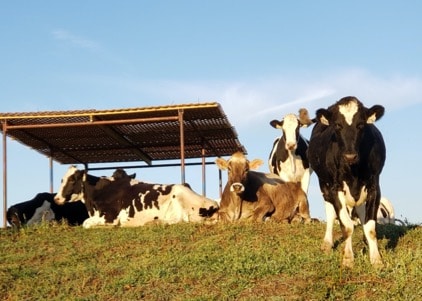 Purdue University dairy cows spend a relaxing afternoon sunbathing. These cows are on a pasture because they are non-lactating and are spending their two months “off” preparing to give birth.
Purdue University dairy cows spend a relaxing afternoon sunbathing. These cows are on a pasture because they are non-lactating and are spending their two months “off” preparing to give birth.
On average, a dairy cow produces 100 pounds of milk per day, which equates to 12.5 gallons. In order to do this, she must consume large amounts of energy and protein to meet her maintenance and milk-producing requirements. Simply providing more dietary energy will only sustain the cow and support milk production for so long because dietary glucose sources cannot be utilized once feed leaves the rumen. Remember back in elementary school when you learned that cows have four stomachs? Did anyone else think that was bizarre, yet cool at the same time? Given that humans are “one stomach” or monogastric mammals, most of my third-grade peers deemed all ruminant species to be “weird”. In fact, ruminant digestive systems are incredibly efficient and much less strange than one may think. My research aims to better understand how the ruminant digestive system, specifically the liver, contributes to energy production and amino acid metabolism. These processes are necessary for a healthy cow and successful farmer.
Ruminant species are classified by the presence of the rumen, which is the large fermentative organ of the digestive tract. The rumen allows for the conversion of human inedible products–such as hays, grasses, or grain–into human edible products, like milk and meat. However, the fermentative capabilities of the rumen create added complexity when identifying what to feed ruminants. The familiar dairy cow provides a good example of the complexity and metabolic potential of ruminants.
 Purdue University cows enjoy a total mixed ration after their morning milking.
Purdue University cows enjoy a total mixed ration after their morning milking.
Unlike our own monogastric systems, which can digest and directly utilize dietary glucose, ruminant systems first convert dietary glucose sources into short chain fatty acids. Most of the short chain fatty acids exit the rumen and go to the liver. In the liver, these fatty acids become the primary carbon source for producing energy. One energy producing pathway is the tricarboxylic acid cycle (TCA cycle). The TCA cycle and other biological cycles that contribute to energy production, will convert short chain fatty acids to glucose or ATP. The glucose and ATP produced in the liver can then be utilized by the cow. This feature means that an important key to improving ruminant feed efficiency (the efficient transformation of feed into energy) is to improve the efficiency of the TCA cycle.
A portion of my research as a Ph.D. student at Purdue University and as a 2019 to 2022 FFAR Fellow focuses on mapping carbon movement through different energy producing cycles in bovine liver. In the simplest of terms, my research question is, “Where does the carbon go in the TCA cycle?” Identifying where and why carbon is lost in the cycle helps feed specialists devise diets for dairy cows that promote optimal energy efficiency. From a producer standpoint, increasing dairy cattle energy efficiency saves money.
My research also focuses on another critical dietary need for dairy cows: protein. Historically, dairy cattle diets have been corn-based. This causes a deficiency in some dietary amino acids. When formulating diets for lactating dairy cows, nutritionists would increase the protein content of the ration to counteract the deficiency caused by the corn-based diet. Over time, we found that increasing dietary protein content increases nitrogen excretion, a byproduct that should be minimized in the environment. A more environmentally and economically sustainable approach is to feed individual amino acids without increasing dietary protein content. Yet there’s a caveat: due to the fermentative capabilities of the rumen, dietary amino acids in an unprotected form are not able to make it past the rumen to be utilized by the cow. Therefore, the amino acids must be delivered to the animal in a fat-encapsulated form. The mechanical and chemical breakdown of digestion allows for the fat coating to be destroyed while the amino acid remains intact for absorption in the small intestine. Part of my research is to test different combinations of amino acids and different ways to deliver these in a meal to dairy cows.
 Purdue University dairy cows spend a relaxing afternoon sunbathing. These cows are in a pasture because they are non-lactating and are spending their two months “off” preparing to give birth.
Purdue University dairy cows spend a relaxing afternoon sunbathing. These cows are in a pasture because they are non-lactating and are spending their two months “off” preparing to give birth.
At the end of the day, everyone involved in animal science wants their animals to be healthy, happy and environmentally and economically sustainable. My research focuses on two ways we can do that for dairy cows.
This work is possible in part by FFAR and Archer Daniels Midland (ADM). I am incredibly honored to be a part of the 2019 to 2022 FFAR Fellows cohort. As we try to feed an exponentially growing global population there is an overwhelming need for integration and cooperation. The FFAR Fellows program provides an ideal format for me to meet emerging scientists from across disciplines.